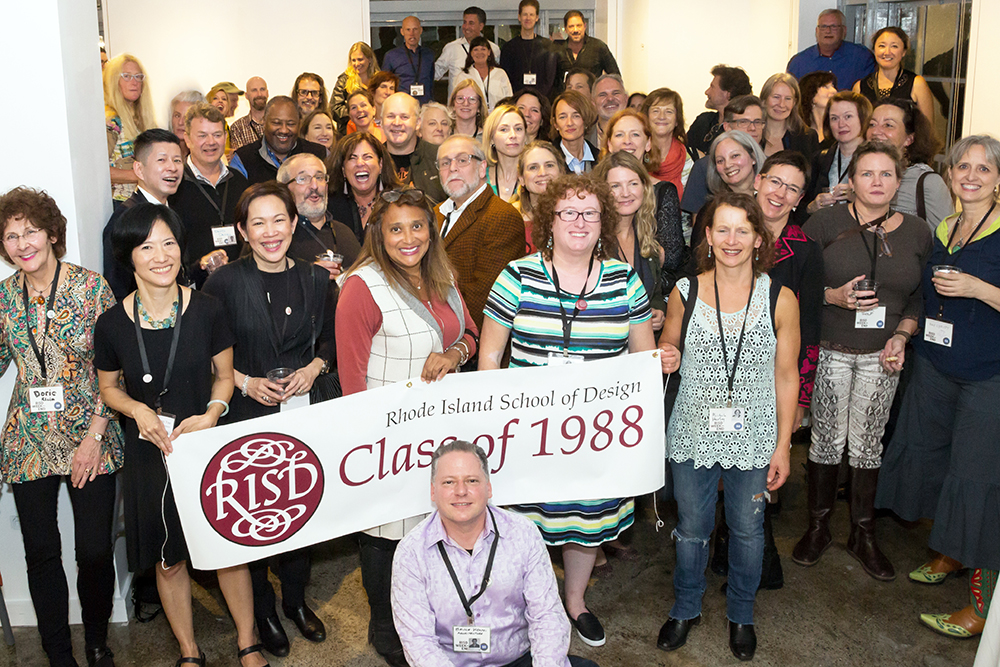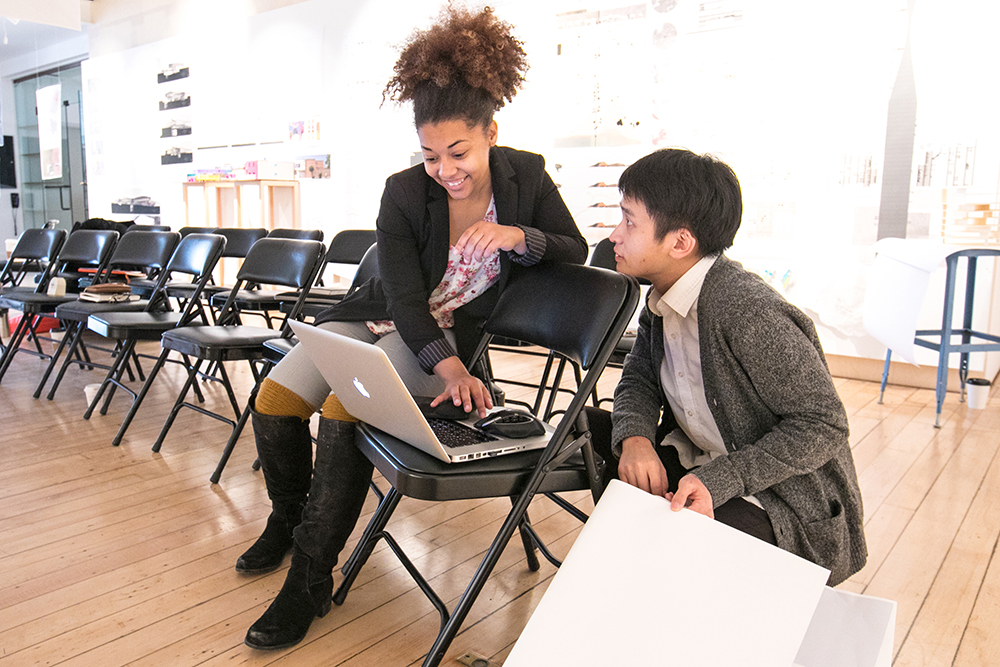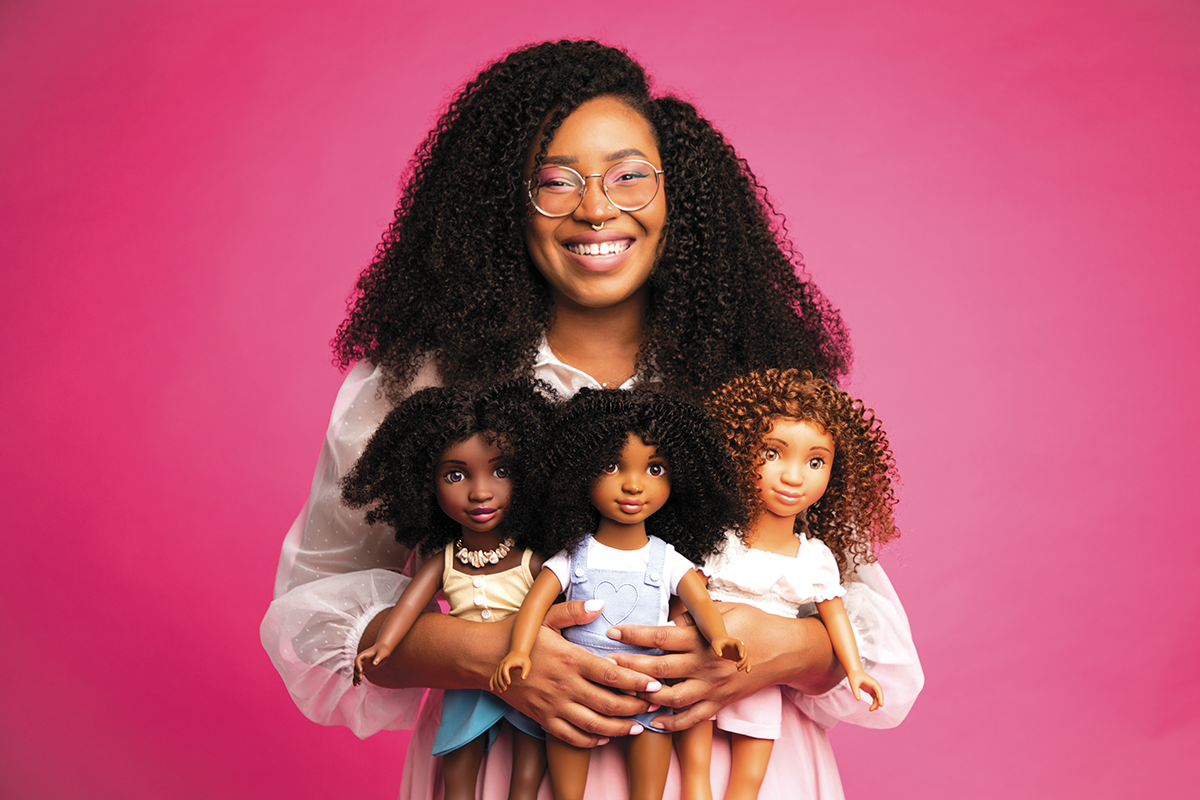
Toy Story
For these three RISD alums, playtime is a full-time job.
Meet the new breed of toy maker. They strive not for a bright, shiny trinket to distract for a flash before disappearing to the bottom of a toy box heaped with the next, the new and the now, but to be architects of fun who create playthings infused with purpose. If they can help it, their toys will never take up space on the curb on trash day, but will be cherished and reused, inhabiting a child’s memory for the make-believe they inspired.
Yelitsa Jean-Charles 16 IL created her first doll as a symbol of the racial inequalities she found herself challenging. “I was a very passionate, feisty student at RISD,” says Jean-Charles. “There were conversations happening all the time on campus about race, gender and sexuality, and I found myself at the center of them. It fueled my work and my passion for change.” Inspired by a fellow student, she started wearing her hair natural for the first time, and in Professor Jean Blackburn’s 3D illustration class, when tasked with redesigning fairy tale characters, she turned Rapunzel into a little brown girl with long, kinky, black hair. “It was a commentary on the fact that people don’t see Black girls as princesses with long, beautiful hair,” she says. But when she stepped back and looked at the character she had created, she realized it looked like a doll—a doll that had never existed for her as a child.
Her class project went from a Kickstarter campaign to $500,000 in grants, awards and pitch competitions to a fully realized product that was the subject of a viral tweet. From there, it became Healthy Roots, a startup that has raised over a million dollars in seed money and has placed three dolls and their accessories in Macy’s and Target stores nationwide. The name Healthy Roots came from Jean-Charles’ desire for “kids to have a healthy root with their identity and their culture and love their hair down to their roots,” she says.
“The company has been able to grow because we developed a great product, we identified a need and we found a way to market it organically through storytelling,” says Jean-Charles, who lives in Detroit. She credits her experience at RISD with teaching her how to use the digital space to tell stories “not necessarily from my classes but through my engagement with social and political issues,” she says.
As an only child growing up in Queens, NY, with parents who had emigrated from Haiti, Jean-Charles says she was not so much the black sheep as the “odd” sheep. She was the only family member who was left-handed and wore glasses, and she spent a lot of time by herself with her books, pencils and coloring books. When she arrived at RISD and learned about Tumblr and saw others making organic viral content, she began to learn the language of the internet. When the time came, she knew how to use it to amplify her mission to empower the next gen-eration and create the diversity and representation she had lacked growing up.
She set out not just to paint a doll brown but to make something different, something that didn’t yet exist—with her nose, her lips, her eyes and her hair. “Many Black girls don’t love their hair, and I thought that this doll could have an impact on their perception of themselves,” she says. After making sketches, spending time in beauty shops and researching toy production, Jean-Charles found a promising material and worked with a factory to create a blend that mimicked the hair she wanted for her dolls. They each have a different texture and different curls that range from kinky to loose. “It was really hard,” she says of the process, “because the toy industry is used to doing things one way.”
She has heard from plenty of customers telling her how much their Healthy Roots doll has meant to them. “People tell us, ‘My daughter hated wearing her bonnet to sleep, but she does it now because her doll has one,’” she says.
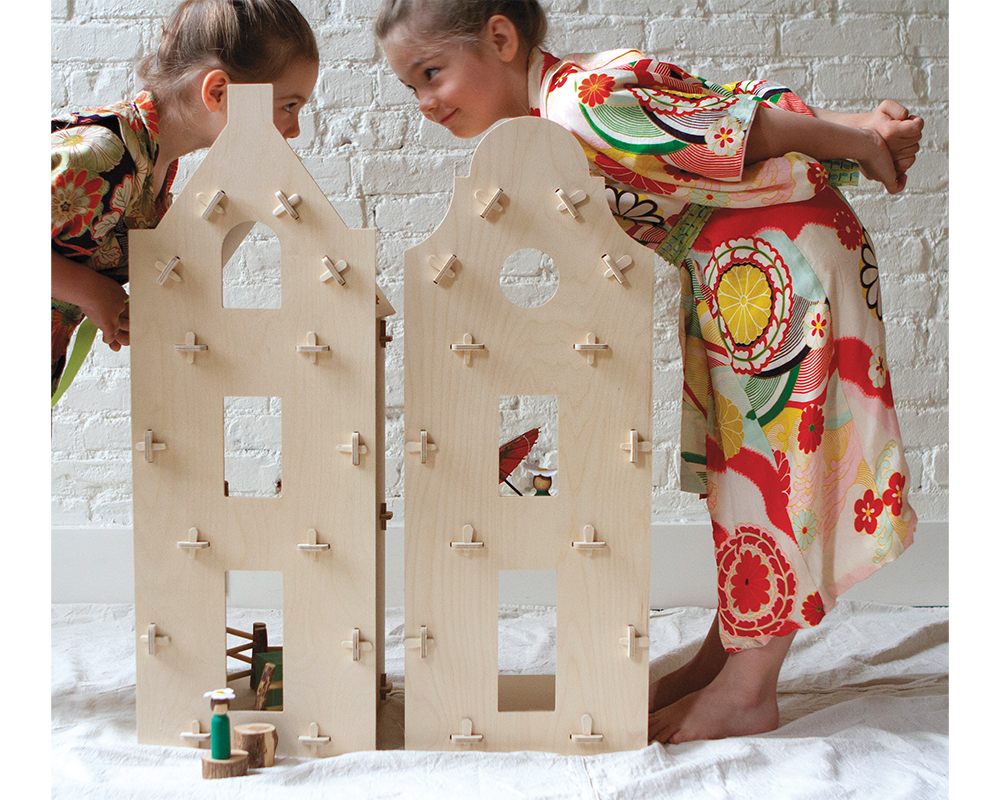
Sarah Unruh 99 FD, the founder of Maquette Kids, originally created her DIY flat-pack dollhouses out of necessity. Her daughter wanted a dollhouse, a toy not typically fashioned after a Brooklyn townhouse such as the one in which Unruh and her family lived. Rather than disappoint her child, she put on her designer hat and got to work.
“I had been doing houseware design for years, working for Martha Stewart and big lifestyle brands, so I was in that decorative-product world. I started thinking of creating a vertical brownstone, something that had a small footprint,” she says.
But instead of focusing on the eye-catching adornments she might prioritize for her professional clients, she consulted her nerdy side and fixated on functionality. “It needed to be stored easily when it wasn’t in use, it had to ship in an efficient way, be manufactured domestically to lessen the environmental impact, and it had to be sustainable,” she says. Unruh knew she wanted to use a natural wood devoid of any toxic finishes. “I thought about whether to add color by using milk paint, but for the most part, I wanted it to be pretty simple. The simpler the better, to allow a child to impose their own creativity on it,” she says.
She began prototyping and sourcing manufacturers —eventually finding one based in New Bedford, MA— and Maquette Kids was born. Maquette, another word for “model,” distills the ethos of the brand: a mini-home as a foundation for open play and discovery.
As Unruh’s kids, now 8 and 11, have grown, they’ve imagined new uses for their dollhouses. “My oldest has one on her desk that she uses to hold her stationery and pens. I’ve been having a lot of fun watching them evolve,” she says.
Another of the driving forces behind Maquette Kids was to create objects that seamlessly blend in and reflect a family’s lifestyle. “They had to be something visually that I wanted to live with,” she says.
Unruh, who sells Maquette Kids from her own website as well as through online retailers, wants to expand to other structures, such as a firehouse. She’s also recently introduced bedding and beds and would love to make cars and other small accessories that kids can assemble themselves. Finding the right domestic manufacturer who can consistently produce the quality she expects remains a chal-lenge. A child’s imagination can go on forever and so should their toys.
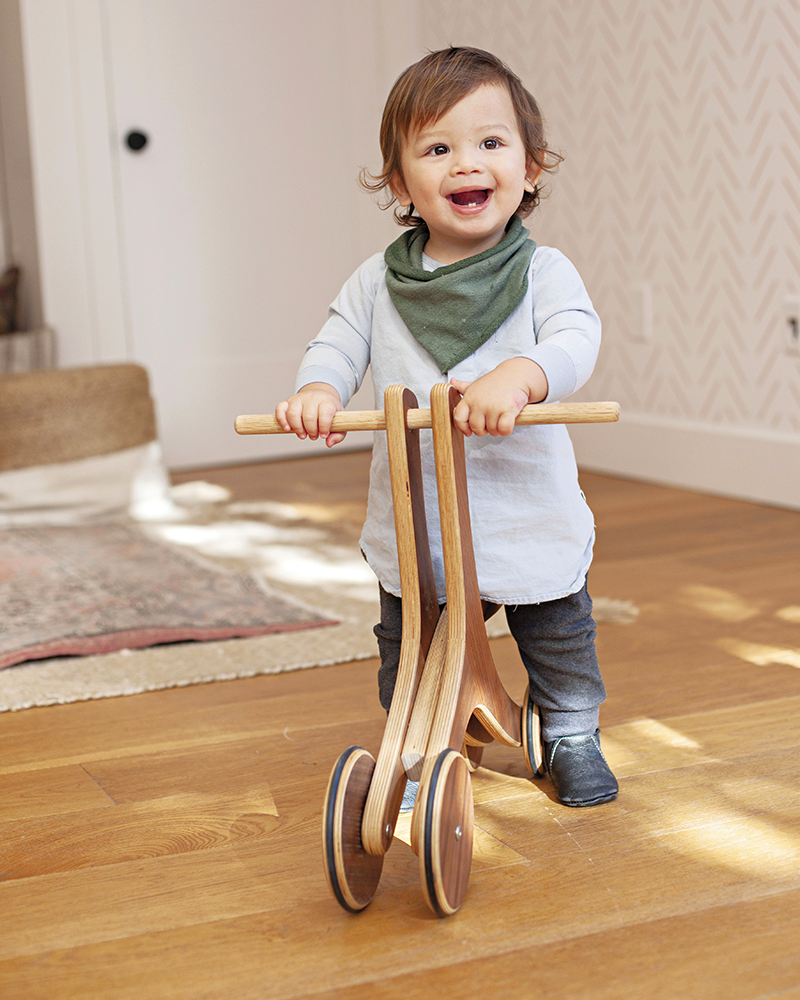
When you’re a parent, hand-me-downs are essential. “We have three kids, and we’re constantly getting rid of things they outgrow and getting new things. We’re environmentally conscious people, and that feels really wasteful for us,” says Amanda White MFA 05 JM, one half of Big Tree Co., the toy company that she started with her partner, Brinton Jaecks MFA 06 DM.
The name is aspirational, implying a growth mindset, and also nods to the idea of a family tree. White and Jaecks met at RISD, where they honed their crafts and also learned that “the only person who’s going to make your ideas real is you. You have to just keep walking up to the idea cliff and jumping off,” says White.
Their own particular idea cliff involved making a ride-on toy that would last and look better than the mostly plastic, easily breakable options currently on shelves, which quickly end up on city curbs next to the broken baby swings and strollers with missing wheels. White made a prototype of a walker for the couple’s second child as a passion project. After seeing their son use it backward like a scooter, she and Jaecks realized this one object could be two, three or four different playthings. “We tried to figure out how long we could make it last. The ideal would be two or three years, the average gap between children. You buy it for your first kid, and then it can cycle for the second kid, and so on. It’s really about trying to reduce waste,” says Jaecks.
What they created is called the Boomerang—the outside frame (made in American black walnut or birch) is a constant, while the middle swaps out to transport it from one stage to the next. It starts as a walker to support your baby’s first steps. Change the middle, narrow the base and add a platform, and it’s a scooter. Remove the middle once more, and add a seat to create your child’s first bike. Finally, take the wheels from four to two, and it’s a balance bike.
“The wheelbase narrows as the kid gets older and learns a sense of balance. The four-wheel bike is integral because it stays still while they get on and off. And then you go down to just two wheels, and they’re gliding and balancing. It creates a sense of adventure and independence and builds their confidence,” says White.
To manufacture the Boomerang, the couple installed a custom computer numeric-controlled (CNC) machine in their garage in Silver Lake, Los Angeles. White quit her job as a jewelry designer and runs the business full-time, while Jaecks, who also works as a visual effects supervisor, helps out when he can. Though they have all the tools to prototype new things, like a play table, they want to grow consciously, not disappoint any customers, and ensure their products are safe. In the meantime, they’re also working on making smaller wooden pull toys. “There’s a real satisfaction when you see a kid learning how to walk with a thing that you made. When you give the Boomerang to a child, they know it’s for them. Their eyes light up and they instantly know what to do with it,” says White. “And when you’re building the product, that brings the fun back.”
Lead image: Healthy Roots founder Yelitsa Jean-Charles with the three “Curl Friends” Gaïana, Zoe and Marisol. Photo by Jasmine Sumlin at Livin For Media.
Words: Abby Bielagus

